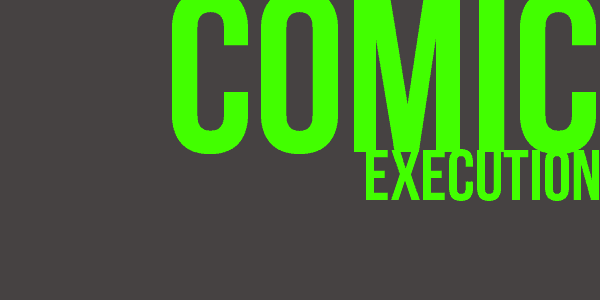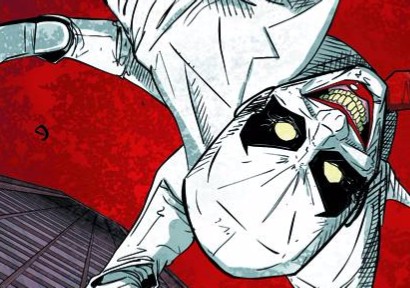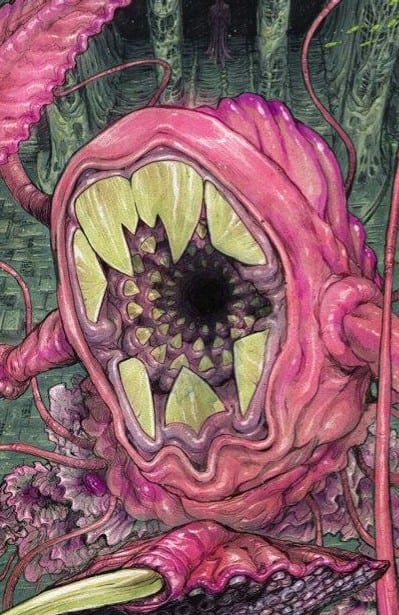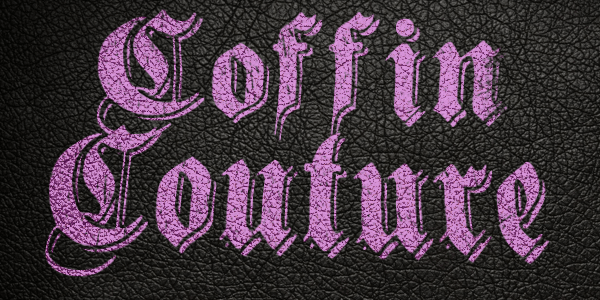
[Comic Execution] 9/19 – HELLRAISER, THE STORYTELLER, TALES OF MR RHEE
I’m turning 30 in a few days. And you know, if I can be serious for a moment, this column right here that you’re reading? It feels like the most important thing I’ve ever done. Not because it has had an impact on sales, because I’m sure it hasn’t. What it has done is motivate me. Most of my creative endeavours are received with little fanfare and that’s fine but when life comes along and gets in the way of that work, I yield to more important things. But what’s happened with Comic Execution is that creators have been responding to my criticism and praise in very honest and human ways and that kind of recognition has pushed it to the top of my list of priorities, because I want to better understand how and why creators do what they do.
Doesn’t help with the whole feeling old thing though.
HELLRAISER: BESTIARY #2
Writer: Christopher Taylor
Ben Meares
Mark Miller
Artist: Jason Shawn Alexander
Amancay Nahuelpan
Carlos Magno
Publisher: BOOM! Studios
Price: $4 (Digital)
Oh, Hellraiser. What a sad story your franchise charts. Probably the best example of horror sequelitis gone wrong, as Hellraiser (as the film script was written) just isn’t a particularly adept story to try and string out into multiple chapters. It would’ve worked better had the film stuck to a more faithful adaptation of The Hellbound Heart, but instead they chopped it up as best they could, which wasn’t easy, I’m sure. But the core problem is that Hellraiser, the original film, revolved around, to some extent, the terrifying mystery of the Puzzle Box. Once viewers knew what waited for anyone unwise enough to unlock it, the appeal was halved. Barker even knew this and tried to retire Pinhead two movies in, but alas, like many classic horror films, he was resurrected over and over, with diminishing returns each time, though a few films in the canon tried futilely to break that mold.
Comics, though, are a different beast. Without a far smaller risk, comics based on the Hellraiser franchise can afford to shatter the rigid, predictable “find box, summon Pinhead, suffer” structure. The second issue of Hellraiser Bestiary proves that, like Barker knew, making Pinhead secondary greatly improves the potential quality of the tale. As before, the comic is a three-part anthology.
The first part, written by Christopher Taylor, is at first totally disorienting; a broken-hearted bluesman sets up at a juke joint and starts strumming away, relating a tale of his chance encounter at a crossroads. I was immediately reminded of an episode of Supernatural that mined the same folklore, appropriating a myth from black culture and allowing the Winchesters to defeat its dangers, so I was certainly a bit wary of how Taylor would inject it into the world of Hellraiser. But fortunately, Taylor hasn’t forgotten exactly how the world of Hellraiser works, even if he warps the format a bit; instead of a puzzle box, the cenobites are summoned by a guitar. But the world they’re summoned in retains the sincere ugliness that defines Clive Barker’s work; everyone’s a victim and characters go from being sorrowful, sympathetic figures to awful monsters in a few twists of the plot that sneak up on you thanks to clever narrative shuffling. The tale ends with Taylor successfully maneuvering the Cenobites into a position of utter non-discrimination and, what’s more, parlays the conceit of a bluesman summoning the Cenobites into an apt allegory for the tortured emotions that the blues so controversially (for the time) conveyed. As a short piece, it manages both to hold onto the spirit of the original Hellraiser while couching it in such a potentially sensitive context in such a way as to be both respectful and incredibly brutal. Great work.
Act two is from one of the writers from the previous book, Ben Meares, who was partially responsible for one of the lesser tales in that volume. His bit for this book is short, clever and genuinely nasty, involving an internet bondage pornographer and his final exploits with the Lament Configuration. There’s some graphic nudity, which is excusable given the circumstances, and the format of everything being seen via streaming webcam is also clever. The twist is a funny one but as soon as I finished reading the whole story, I felt like Ben Meares had sorely missed an opportunity to really mess with the reader by going meta. But my real gripe with this story is how, like so many first-person-horror webcam movies, it reeks of cheapness. By limiting the POV to the webcam monitor, most of the panels only feature one character, just sitting in a chair for most of the pages. It’s also a bit tacky, as the victim behaves as though she’s a complete imbecile and the whole thing doesn’t quite read as satire.
The last part of the book is a continuation of the third chapter from the first issue, and sees a group of mercenaries successfully capturing Pinhead for the purposes of extracting his pins. Notably, the men in the group all fail to pry the nails free, so it’s up to the sole female to find a grim solution, if not a particularly clever one. Pinhead gets to be totally awesome for the rest of the issue though honestly, it’s a bit of cognitive dissonance that the hunters have enough guile to defeat Pinhead but not enough to wait and make sure he’s dead. This episode has a pretty clever twist at the end as well but there’s more promise than anything to it, giving the compact narrative a bit of impact.
The art from the first story is done by Jason Shawn Alexander, a fantastically talented illustrator whose expressive, painterly style is perfect for the time period, adding layers upon layers of texture and emotion to each page. The art exudes realism but retains a grim mood throughout, mainly thanks to the heavily limited color palette, one that grates on the nerves a bit after a while. It feels as though Alexander did the lines passionately, then had to cut corners on the colors, which is a shame. But there are so many panels that are breathtaking anyway, and his layouts transcend the cinematic. The art for part two is not really worth mentioning. It’s not bad, certainly, but given that the setting and POV only changes once between 24 panels, it wouldn’t be fair to evaluate their skill based on what I see here, though there’s talent on display, certainly. And, as with the prior issue, our last tale is fleshed out fantastically by Carlos Magno, whose bold, punchy yet detailed lines continue to drive the frenzied, violent mood of this segment. Take what I said about his work in the last issue and double the praise for illustrating Pinhead’s private inferno in searing fashion.
There’s 22 pages of comic in Hellraiser Bestiary #2, but only 18 of those pages are worth considering. If BOOM! Studios did the smart thing and dropped the unnecessary middle story and dropped the price from $4 to, say, $3.50, you’d have a deal on your hands. As it is, this is $4 for a comic that’s just not that good, especially considering how much more enjoyable it would be if it was told one story at a time, rather than three in one volume. Pinhead may have survived the events of this issue, but Hellraiser Bestiary will not survive with him in the pages of this comic.
JIM HENSON’S THE STORYTELLER: WITCHES #1
Writer: SM Vidaurri
Artist: SM Vidaurri
Publisher: Archaia Entertainment
Price: $4 (Digital)
SM Vidaurri is known for Iron: Or The War After, a fantastic historical thriller set in a nameless Cold War Europe country populated by anthropomorphic creatures, which I fell in love with when I stumbled across it at my local comic book shop. It wasn’t just an incredibly beautiful comic but a moving, finely-wrought story as well. But his activity beyond that has been hard to track down, with a sprinkling of contributions here and there. The Storyteller: Witches represents the first significant work of his own in a while, being both written and illustrated by him. In case you aren’t familiar, the “The Storyteller” title derives from the TV show Jim Henson’s The Storyteller, the property that the comic is loosely based on. This is an interesting part of the context of the comic, but that discussion will happen after we talk about the contents.
Vidaurri takes a lesser known Russian fable about Baba Yaga and expands on it by incorporating another obscure myth, the Lord of the Forest, entwining the two in a way that updates the old folklore for a modern era yet still feels like it could be a legitimate artifact. The interpretations of those archetypes, like the Princess and the Witch, are subtly colored to give a feminist conceit to the proceedings. It becomes obvious near the climax but the way it unfurls is dignified and organic enough that it doesn’t feel like he’s hammering the theme home so much as embroidering it into the fabric of the narrative. For example, his Baba Yaga is neither an old crone, nor a Disney-esque sprite, and has motives that are neither altruistic nor malevolent, which sticks to the Baba Yaga character or not, depending on which of a dozen traditional variations you’re comparing. And the Lord of the Forest, while certainly as brusque and unwavering as the natural forces he represents, is softened by his injured motives. It’s hard not to compare Vidaurri’s story to Frozen but where that movie established an identity outside the roots of its origins, The Magic Swan Goose And The Lord Of The Forest embraces the surrealism of Russian folklore, harkening back to classic Disney, and for that, Vidaurri earns my praise.
But what’s really the star of the show is SM Vidaurri’s art. First off, rather than opt for a standard multi-panel layout like most comics, Vidaurri does each page as a single or double panel that are centered on a background of a fresh pattern with every turn of the page. While this could be cynically seen as a way of expanding a short work into a comic of standard length, that would discount entirely the hugely effective mood it saturates the whole affair with. This is yet another way that SM Vidaurri recalls classic Hans Christian Anderson or Brothers Grimm, as most presentations of those fables were accompanied by illustrations identically formatted, usually minus the lovely background trim. The linework is, as usual, simple but nuanced, with that timeless feel that he’s so well known for, and justifiably. But, as with this kind of multi-talented types, his lines and colors and POVs all seamlessly synchronize to augment each other. It makes a very effective case for encouraging more artist/colorists types. His designs for characters like The Lord Of The Forest are iconic and have depth beyond simply being fairytale-ish. In one scene, the Princess takes on a crown imbued with magic and dons a suit of armor. This isn’t just to look cool; the armor itself has notes of Eastern European style to it, being both elegant and intimidating, which represents her wielding of said power.
There’s a case to be made here, if anything, that this work might be superior to Iron: Or The War After. Rarely does a reinterpreted fairy tale contain this much layered complexity and still present a pleasing experience. Where Iron was weighed down, to some extent, by its heavily political tone, this story only unveils its depths upon close examination and that’s hugely commendable given that its target audience are kids. In fact, I’d even go so far as to say that Disney/Dreamworks should be hiring Vidaurri ASAP to work his magic under their wings, as he one-ups both Brave and Frozen handily by remembering how fantastic yet simple folklore was. Basically, and this is summarizing far too handily for something that genuinely made me a bit teary eyed, with his chapter of The Storyteller: Witches, SM Vidaurri has effectively bridged the modern and classical eras of Disney, something they’ve yet to do, much to my dismay.
Now, to the bad news. SM Vidaurri will not be present in the next issue of The Storyteller: Witches. What publisher Archaia (who also handled Iron) should be doing is freeing SM Vidaurri from the restraints of working with licensed material (something I’d like to see a lot less of in comics in general) and paying him generously to do whatever the hell he wants. There’s 25 pages of incredibly beautiful and passionately crafted fairy tale in this volume but at only $4 it seems like a gift. Of course, if you have absolutely no interest in fairy tales or pleasing the child in you, I guess you could ignore this entirely. But that would be your mistake. I only feel sorry for Kyla Vanderklugt, who has to follow this up.
 TALES OF MR RHEE: KARMAGEDDON #1
TALES OF MR RHEE: KARMAGEDDON #1
Writer: Dirk Manning
Artist: Seth Damoose
Colorist: Anthony D Lee
Publisher: Devil’s Due Entertainment
Price: $2 (Digital)
Oh, indie comics. On the one hand, indie comics are a chance to get exposure for creators who otherwise wouldn’t be given a chance in mainstream comics. On the other hand, sometimes there’s a reason those creators shouldn’t be given those chances. Tales of Mr Rhee Armageddon is the result of one of those situations. I was scouring Comixology, as has becoming a weekly routine, for something format-appropriate to review and this was one of the few options I had available to me in the regard, so here I am, to tell you how much you shouldn’t read this.
It’s a follow-up to Tales of Mr Rhee, a series from a while back, and there’s been an indeterminate time passing between the two narratives, during which a demonic apocalypse has ravaged America (and probably the world). Mr Rhee, one of the few who tried to halt said apocalypse, is now trying to survive, and so we end up with a sort of Supernatural + The Walking Dead type situation. In fact, that feels almost exactly like what writer Dirk Manning is trying to evoke, and quite successfully, I might add. That’s not a good thing. Main character Mr Rhee is such an enigma, he’s barely relatable, and the survivors he encounters are much less so. There’s some kind of religious commentary going on here but the tale is so fractured, it’s hard to get a grasp on what Manning is aiming for. Even worse, there’s a scene where Manning goes over the edge and makes Mr Rhee a victim of statutory rape, bluntly presenting it in a flashback that’s unintentionally comedic by merit of being offensively absurd.
None of this is helped even remotely by the artwork of Seth Damoose. His style is definitely cartoony and would fit perfectly into an Archie comic. But a grim dark tale like this just results in an intense cognitive dissonance. Colorist Anthony D Lee also fails to recognize this and makes sure the colors are crisp and bold, making the clear discontinuity between the story and visuals even worse. If this were a superhero comic or an action comic even, it wouldn’t be so grating but this is like putting chocolate syrup on a plate of spaghetti.
Wasting any more time talking about this comic is fruitless. It’s written by someone with no grasp of subtlety or tact and illustrated by talent artists who simply aren’t suited to the content. Even at a paltry $2, there’s just so much wrong with this comic I can’t possibly condone paying to read it.



